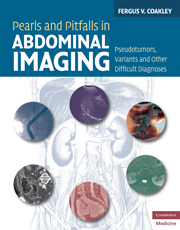Book contents
- Frontmatter
- Contents
- Preface
- Acknowledgements
- Section 1 Diaphragm and adjacent structures
- Section 2 Liver
- Section 3 Biliary system
- Section 4 Spleen
- Section 5 Pancreas
- Case 31 Groove pancreatitis
- Case 32 Intrapancreatic accessory spleen
- Case 33 Pancreatic cleft
- Case 34 Colloid carcinoma of the pancreas
- Section 6 Adrenal glands
- Section 7 Kidneys
- Section 8 Retroperitoneum
- Section 9 Gastrointestinal tract
- Section 10 Peritoneal cavity
- Section 11 Ovaries
- Section 12 Uterus and vagina
- Section 13 Bladder
- Section 14 Pelvic soft tissues
- Section 15 Groin
- Section 16 Bone
- Index
- References
Case 31 - Groove pancreatitis
from Section 5 - Pancreas
Published online by Cambridge University Press: 05 November 2011
- Frontmatter
- Contents
- Preface
- Acknowledgements
- Section 1 Diaphragm and adjacent structures
- Section 2 Liver
- Section 3 Biliary system
- Section 4 Spleen
- Section 5 Pancreas
- Case 31 Groove pancreatitis
- Case 32 Intrapancreatic accessory spleen
- Case 33 Pancreatic cleft
- Case 34 Colloid carcinoma of the pancreas
- Section 6 Adrenal glands
- Section 7 Kidneys
- Section 8 Retroperitoneum
- Section 9 Gastrointestinal tract
- Section 10 Peritoneal cavity
- Section 11 Ovaries
- Section 12 Uterus and vagina
- Section 13 Bladder
- Section 14 Pelvic soft tissues
- Section 15 Groin
- Section 16 Bone
- Index
- References
Summary
Imaging description
Groove pancreatitis, first described in 1973, is a rare form of focal chronic pancreatitis that occurs in the “groove” between the pancreatic head, duodenum, and common bile duct [1–3]. Cross-sectional imaging typically demonstrates a mass in the pancreatic head adjacent to the duodenum that is hypoechoic at ultrasound, poorly enhancing at CT, and iso- or slightly hyperintense on T2-weighed MRI with delayed enhancement after intravenous gadolinium on T1-weighted images (Figures 31.1 and 31.2) [4–6]. The pancreatic and common bile duct may show smooth tapering but are usually not markedly dilated and jaundice is rare. Intralesional cysts and duodenal narrowing or wall thickening may also be seen [6, 7].
Importance
Groove pancreatitis is frequently misdiagnosed as pancreatic adenocarcinoma. Many cases go to surgery with malignancy as the preoperative diagnosis [8].
Typical clinical scenario
Groove pancreatitis has been primarily reported in middle-aged alcoholic men [2, 3]. The etiology of the condition is unknown, but suggestions include inflammation secondary to blockage of the duct of Santorini or inflammation of heterotopic pancreatic tissue [8].
Differential diagnosis
The confident distinction between groove pancreatitis and adenocarcinoma of the pancreatic head is often difficult on imaging. The lack of marked biliary dilatation in the presence of an ill-defined pancreatic head mass should suggest a diagnosis other than primary pancreatic adenocarcinoma, and raise consideration of groove pancreatitis.
Information
- Type
- Chapter
- Information
- Pearls and Pitfalls in Abdominal ImagingPseudotumors, Variants and Other Difficult Diagnoses, pp. 104 - 107Publisher: Cambridge University PressPrint publication year: 2010
